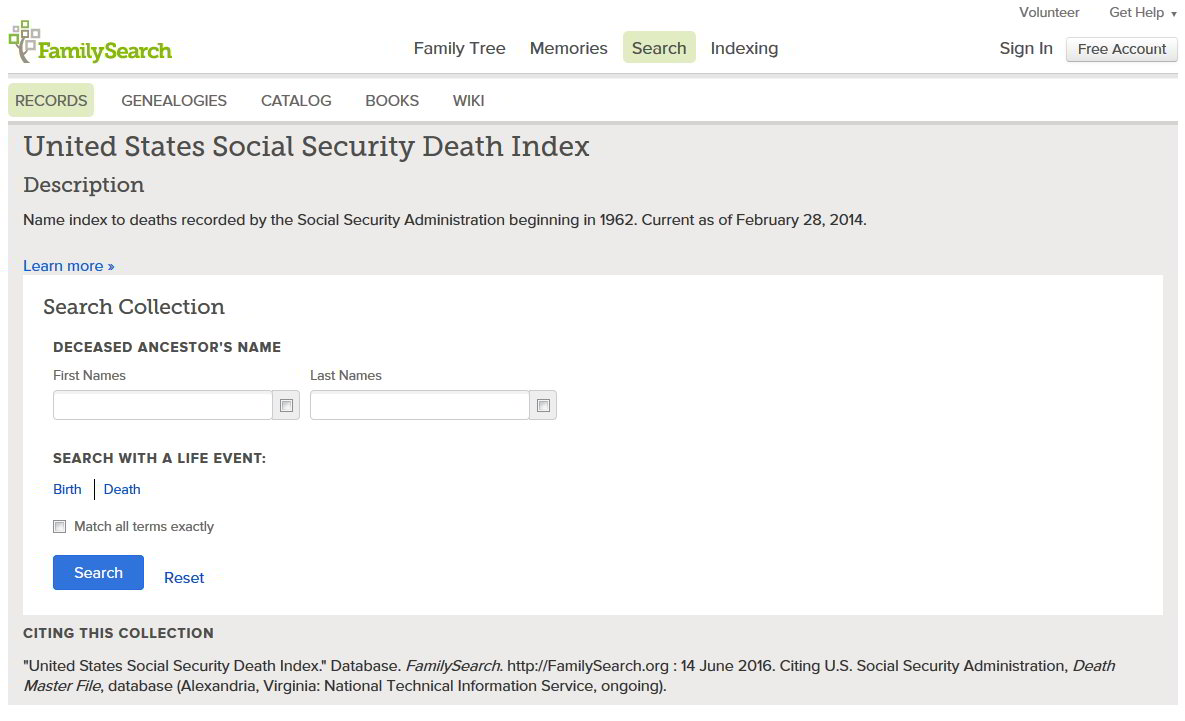Searching the U.S. Social Security Death Index

Some of the best sources for genealogy records come from interactions between our ancestors and the United States federal government. The Social Security Death Index (SSDI) is a collection of records listing deceased people in the U.S.
The index could yield important information about the more recent generations of your family. The data elements contained within each record include name, date of birth, date of death, state or country of residence and zip code of deceased’ last residence.
The value of this collection comes from its size (nearly 100 million records); if your deceased ancestor was issued a social security number, there is a good chance a record will exist for them.
If someone is missing from the list, it may be that the benefit was never requested, an error was made on the form requesting the benefit, or their death was never reported to the Social Security Administration.
History of Social Security
The social security number is so integrated into American everyday life that we tend to take it for granted, but this has not always been the case. The Social Security Act was signed into law by President Roosevelt on August 14, 1935.
In addition to several provisions for general welfare, the Act created a social insurance program designed to pay retired workers age 65 or older a continuing income after retirement.
The Social Security Administration (SSA) is the government organization created to oversee the new benefit. The dire economic times of the Great Depression destroyed the value of many Americans’ retirement savings and highlighted the need for a safety net to protect the elderly.
Social Security was a major component of President Roosevelt’s New Deal package of reforms meant to prevent a repeat of the human suffering caused by the Great Depression.
Social Security Death Index
The Social Security Death Index is a database of death records created from the United States Social Security Administration's Death Master File Extract. The deaths of people after 1936 with a social security number are recorded by the Social Security Administration in this database.
Due to security concerns about possible identity theft, the
Social Security Administration changed their policy in 2013 about releasing the
most current records. They now do not
release records for three calendar years after an individual’s death.
Also keep in mind that the absence of a particular
person in the SSDI does not prove this person is alive. The Social Security Administration does not
guarantee the accuracy of the file, so it may contain errors or omissions.
How can I access the SSDI for free?
Thanks to the folks at FamilySearch.org, the SDDI can be searched for free at:
https://familysearch.org/search/collection/1202535

The content of its database is not complete (most of the people in this index died after 1962) and may contain errors. Taking these shortcomings into account, the Social Security Death Index still provides a valuable tool for genealogists.
There is no real downside to spending a few
minutes searching for your family members who died in the United States after
1936. Especially given the fact that you
can search it free of charge at FamilySearch.com without the need to leave the
comfort of your own home.
Read related articles: Record
Sources
Beginner
Guide
Genealogy Quick Start Guide for Beginners
Applying the Genealogy Proof Standard to your Research
Google Genealogy Research Toolbox
Find Records
Researching Ancestors through Military Records
Using the National Archives (NARA) for Genealogy Research
Using U.S. Census Records
Canadian Genealogy Research using the Internet
Tips
Genealogy Source Citations Made Easy
Listening to Genealogy Podcasts Made Easy

